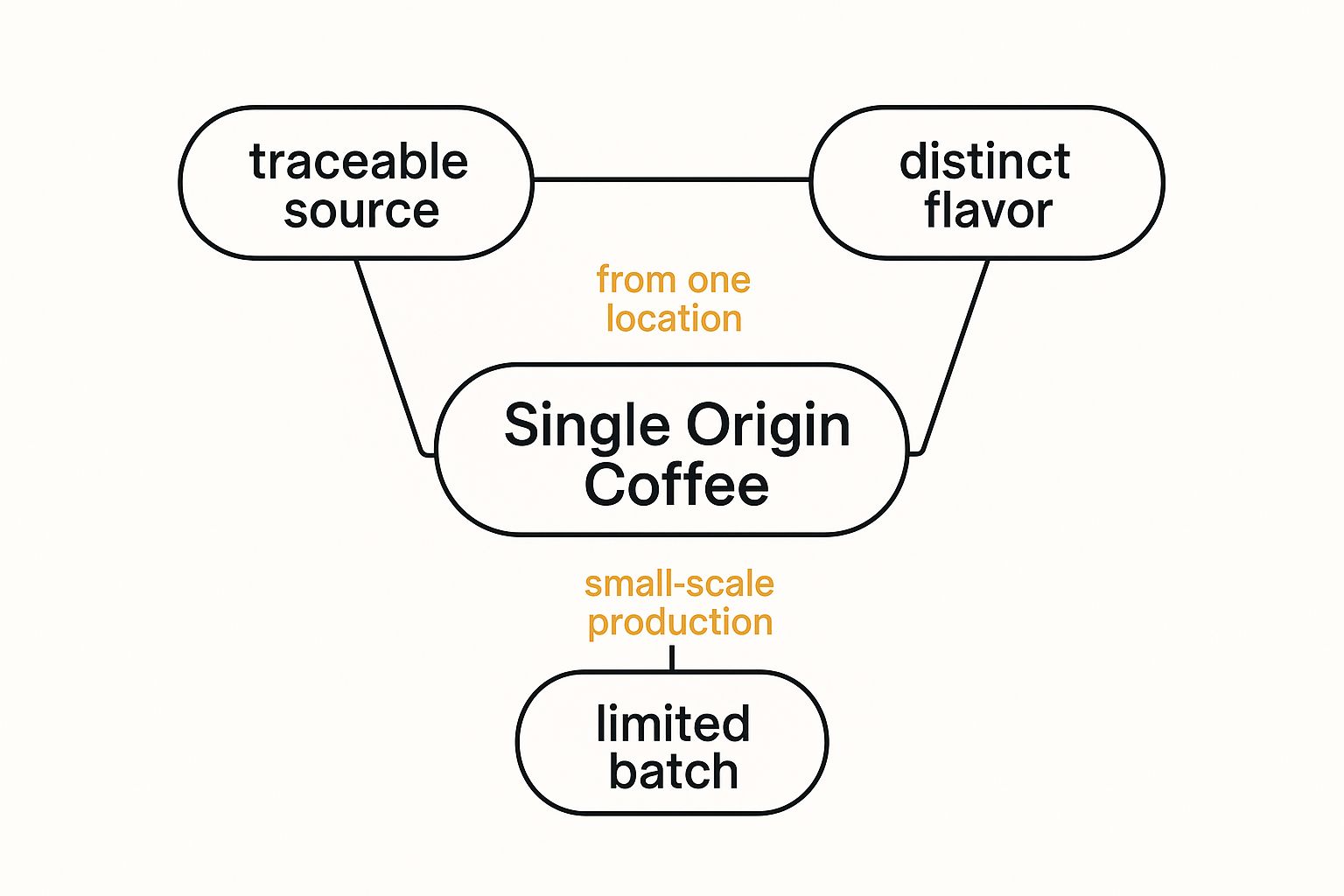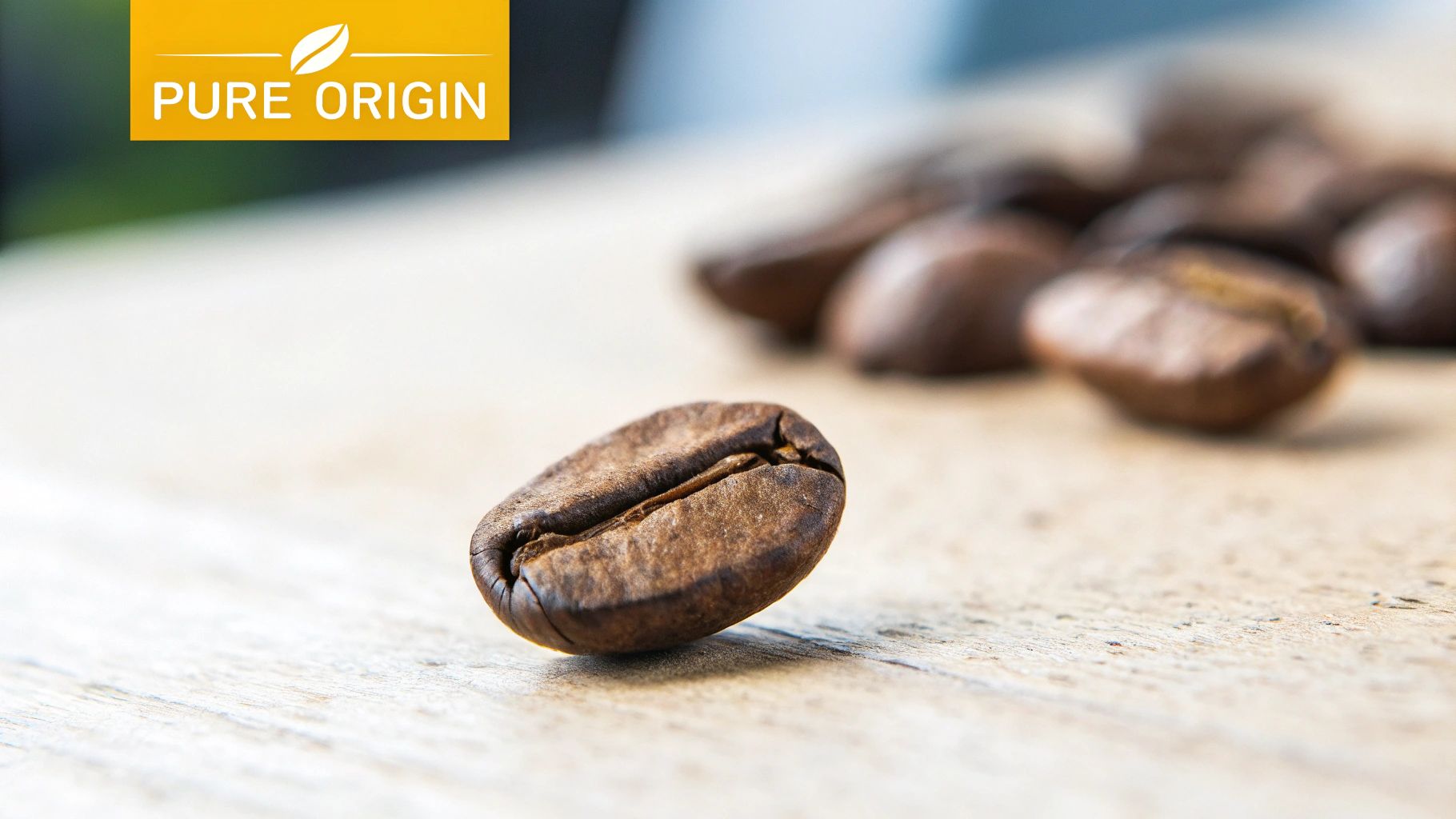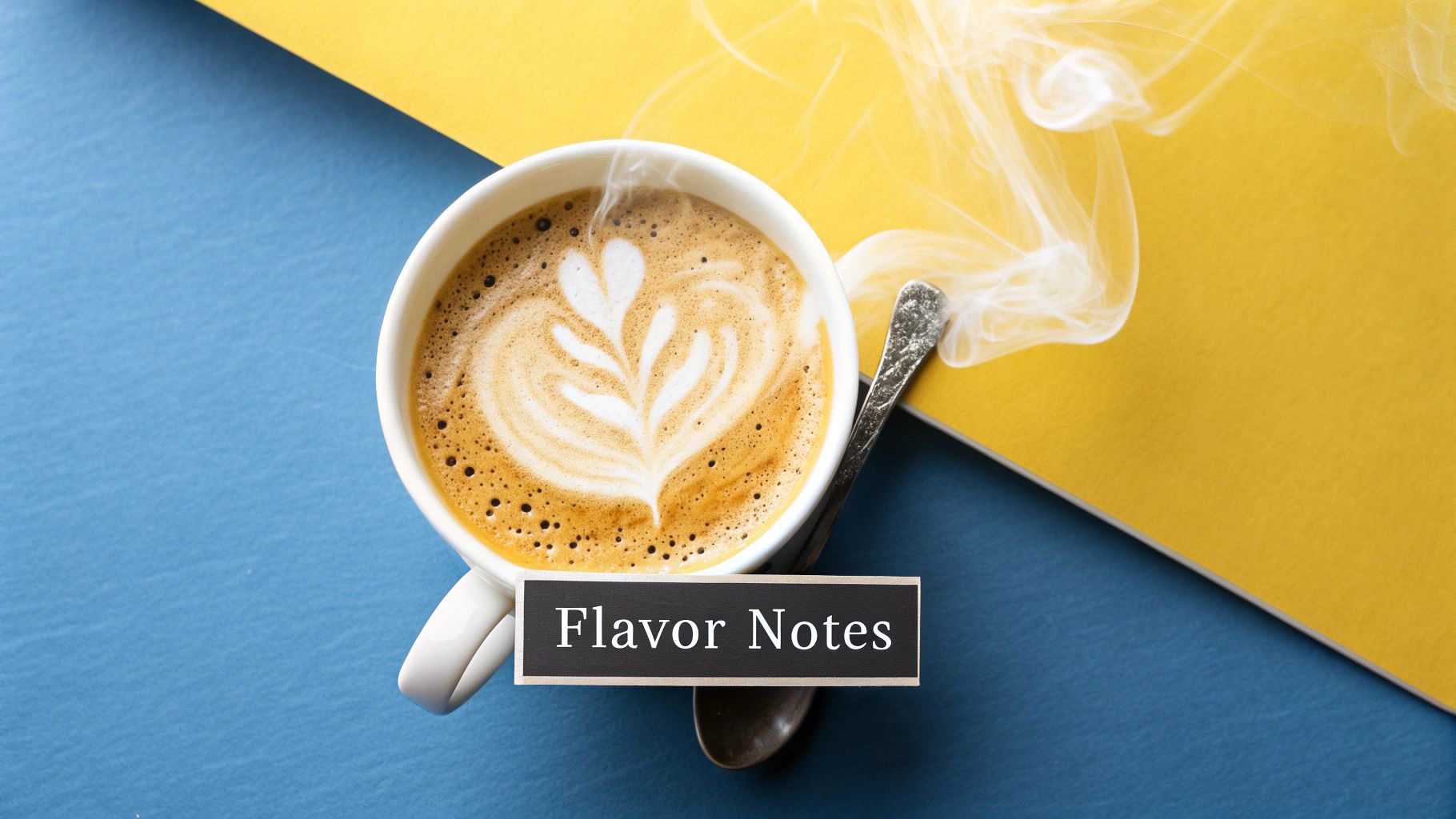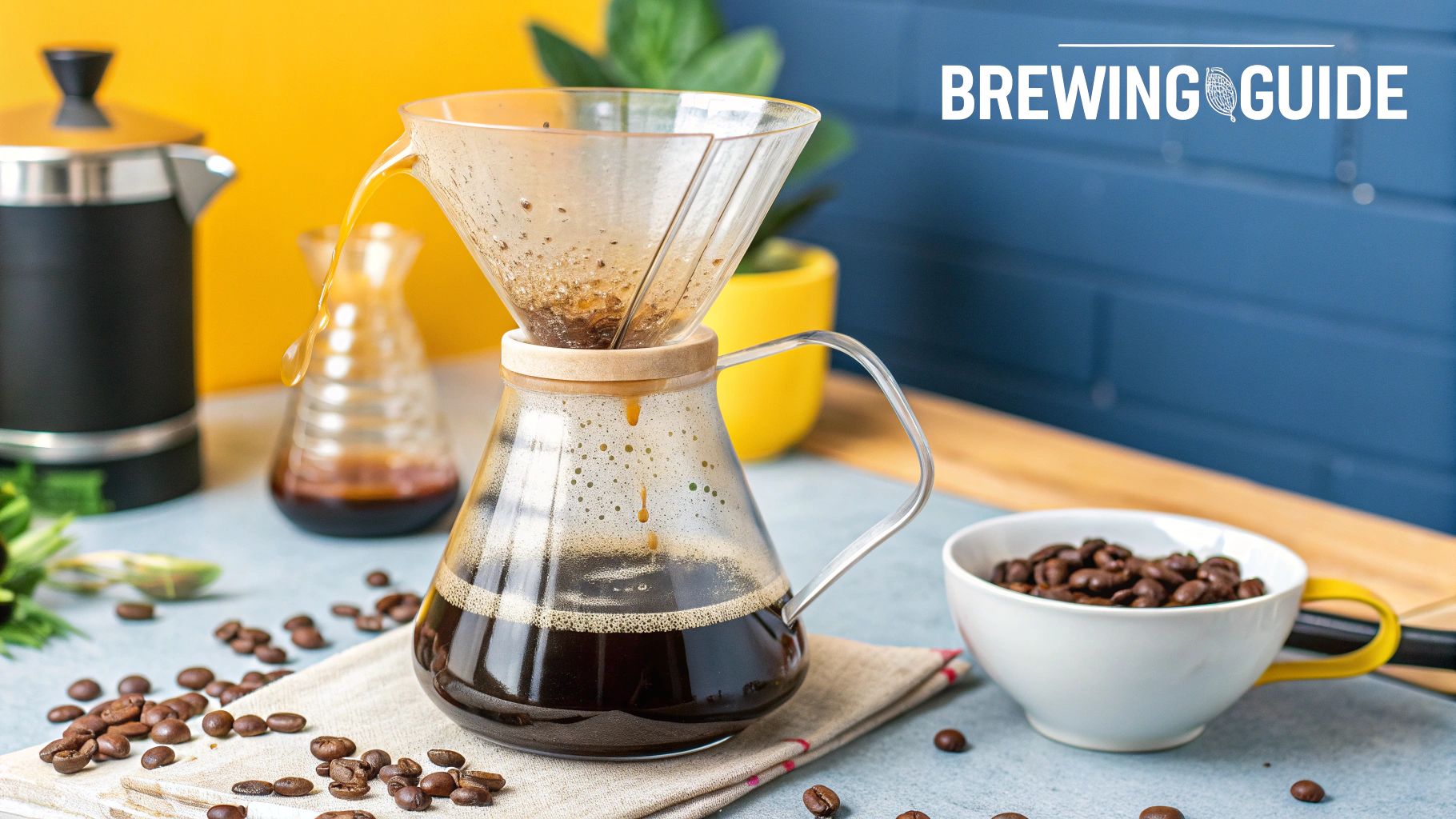So, what exactly is single origin coffee? Put simply, it’s coffee that comes from a single, specific place. This could mean one farm, one cooperative of farmers, or one specific region within a country. The key is that the beans are not mixed with others from different locations, giving you a pure, traceable flavor that tells the story of where it grew.
Unpacking the Meaning of Single Origin
Think of single origin coffee like you would a fine wine from a specific vineyard. A blended wine pulls grapes from all over to create a consistent, reliable taste. But a single-vineyard wine? That’s all about expressing the unique character of its little plot of land—the soil, the climate, everything. Single origin coffee is the exact same idea, offering a pure taste of its terroir.
This focus on a single source means the flavor is often more distinct and adventurous than what you’d find in a blend. Blends are designed for consistency, balancing out different beans to create a taste you can count on year-round. Single origin, on the other hand, celebrates seasonality and variation. It’s a snapshot of a particular harvest from a specific place, giving you a direct connection to the farm and the people who grew the coffee.
Single Origin vs Blends at a Glance
To make it even clearer, let's break down the fundamental differences between single origin coffees and blends. This quick table highlights what sets them apart.
| Characteristic | Single Origin Coffee | Blended Coffee |
|---|---|---|
| Source | A single farm, estate, or region | Beans from multiple origins |
| Flavor Profile | Distinct, unique, reflects its terroir | Balanced, consistent, and complex |
| Goal | Showcase the unique character of one origin | Create a consistent, reliable flavor |
| Availability | Often seasonal and in limited batches | Available year-round |
| Best For | Adventurous drinkers, pour-overs, filter coffee | Espresso, consistent daily drinkers |
Ultimately, neither is "better" than the other—they just offer different experiences. A single origin is for exploring unique flavors, while a blend is for enjoying a consistent, well-rounded cup.
The Core Concepts
So, what truly sets single origin coffee apart? It really boils down to a few key ideas.
- Traceability: You can trace the coffee right back to its roots, often down to the specific farm or washing station. This transparency builds a real connection between you and the producer.
- Distinct Flavor: The coffee’s taste is a direct result of its environment. Things like soil minerals, rainfall, and altitude create a flavor profile that you just can’t replicate anywhere else.
- Seasonality: Just like fresh fruit from the farmer's market, single origin coffees are often seasonal. Their availability is tied to the harvest cycles of their region, which makes them exciting, limited-batch offerings.
This is what makes every bag of single origin coffee a unique experience.

As you can see, it's a simple but powerful concept: a traceable source leads to a distinct flavor that's often only available for a short time.
Tracing Coffee's Journey From Farm to Cup
Every bag of single origin coffee has a story to tell, and that story always starts with the land. Just like a fine wine, the specific environment where coffee grows—its terroir—gives every bean a distinct personality. This isn't just about what country is on the label; it’s about the unique blend of soil, climate, and altitude of a single farm or a tiny, specific region.

Think about two coffee farms, maybe just a few miles apart. One might be perched high on a volcanic slope, its mineral-rich soil producing beans with a bright, citrusy acidity. The other, tucked away in a shaded valley with its own microclimate, could grow beans with a deep, chocolatey sweetness. It’s this incredible sensitivity to place that makes single origin coffee so fascinating.
These small, subtle differences are exactly why knowing your coffee’s origin is so rewarding. You're getting a direct link to a specific plot of land and the unique conditions that shaped its flavor.
The Farmer's Craft and Meticulous Choices
But the land is only half the story. The other half belongs to the farmer. From the second a coffee cherry is plucked from the branch, a series of deliberate choices begin that will shape the final taste in your cup. It’s a true craft, built on care and precision.
It all starts with the harvest. For the kind of specialty-grade single origin coffee we love, farmers often use selective picking, where only the perfectly ripe cherries are gathered by hand. This is a painstaking process, but it guarantees that every bean has hit its peak sweetness and flavor—a world away from mass-market methods where underripe and overripe cherries are all scooped up together.
After the harvest comes processing, and this is where a farmer can really steer the coffee’s flavor profile. The two most common paths are:
- Washed Process: The fruit pulp is scrubbed off the bean before it's dried. This technique creates a super clean, crisp cup that lets the bean's natural acidity and bright flavors take center stage.
- Natural Process: The whole cherry is dried with the bean still inside, letting the fruit's sugars ferment and soak into the bean. The result is a coffee with a heavier body, lower acidity, and intense, fruity, almost wine-like flavors.
Choosing a processing method isn't just a technical step; it's an artistic one. A farmer might use the washed process to highlight the delicate floral notes of a Geisha variety, or go with the natural process to bring out those big, bold blueberry notes in an Ethiopian heirloom bean.
From Global Markets to Your Grinder
The journey from a single, specific farm to the global market is both complex and fascinating. Global coffee production trends have a huge say in which single origin coffees you and I can get our hands on. For the 2025/26 season, forecasts are predicting a record 178.7 million bags of coffee produced worldwide. Ethiopia's bumper crop, for instance, helps supply the distinct Arabica varieties so prized in the single origin world. Even so, record-high consumption keeps supplies tight, which of course affects the price and availability of these special lots.
Every choice—from the farm's location to the processing method—is another brushstroke in the coffee's final portrait. That’s why a bag of single origin isn't just a product. It's a promise of an authentic experience, a taste of a specific place and time, and a tribute to the dedicated craft that brought it all the way to you. In the same way, understanding different preparations, like what is coffee concentrate, helps you appreciate the full spectrum of coffee experiences out there today.
Exploring a World of Flavor in Your Cup
Diving into the world of single origin coffee is a bit like becoming a globe-trotter, one cup at a time. Because each coffee comes from one specific place, it carries a unique flavor signature you just can’t find anywhere else. It’s a genuine journey for your taste buds, where the destination changes with every new bag you open.
Forget that generic "coffee" flavor. Single origin is all about the specifics. A coffee from Ethiopia might burst with bright, floral notes and a zesty, almost citrus-like acidity. It's a vibrant and lively experience, often with hints of blueberry or jasmine. You’re not just tasting coffee; you’re tasting the sunny highlands of Yirgacheffe.
Decoding Regional Tastes
To really get what single origin coffee is all about, it helps to know the general flavor profiles that come from the major growing regions. Of course, every farm is unique, but these characteristics are a great starting point for finding what you love.
Let’s compare a few popular origins:
- Ethiopia: Often called the birthplace of coffee, these beans are famous for their bright, clean, and floral notes. Expect flavors like bergamot, berries, and a wine-like acidity that makes for an exciting and complex cup.
- Guatemala: Coffees from this Central American powerhouse are known for their balance and richness. You'll often find deep notes of milk chocolate, toffee, and nuts, with a pleasant sweetness and a full body.
- Indonesia (Sumatra): These beans offer a completely different experience. They are typically earthy, spicy, and full-bodied, with low acidity. Look for flavors like dark chocolate, cedar, and even a hint of sweet tobacco.
This incredible diversity is what makes exploring single origin so rewarding. You’re not just choosing a coffee; you’re choosing an entire sensory landscape to explore.
Learning the Language of Flavor
Tasting coffee is a skill, but you definitely don't need to be an expert to start figuring out what you enjoy. The key is simply to use relatable comparisons to describe what you're experiencing. Sure, coffee pros use a tool called a "flavor wheel," but you can start with much simpler ideas.
When you see "tasting notes" on a coffee bag, it doesn't mean artificial flavors have been added. These are the subtle, natural flavors and aromas that come from the bean’s origin, how it was processed, and its roast profile. It’s the coffee's inherent character shining through.
Think about the coffees you drink in terms you already understand. Does the acidity remind you of a crisp green apple or a juicy orange? Is the sweetness more like rich caramel or a light, floral honey? Does it have a smooth, creamy body like milk, or is it thinner, almost tea-like?
Here are a few common descriptors to listen for on your next tasting:
- Acidity: This isn’t sourness, but rather a bright, tangy quality that adds liveliness. Think of the pleasant sharpness of a raspberry.
- Body: This is all about the weight or texture of the coffee on your tongue. Is it heavy and syrupy, or is it light and crisp?
- Sweetness: Look for notes ranging from deep molasses and brown sugar to delicate floral honey.
- Finish: What taste lingers after you swallow? It might be a clean, quick finish or a long, chocolatey aftertaste.
By paying attention to these simple elements, you can start building a mental map of your own flavor preferences. This is what empowers you to confidently select your next single origin coffee, turning every cup into a deliberate, delicious discovery.
Why You Should Choose Single Origin Coffee
Picking a single origin coffee is about so much more than just what's in your cup. It's a deliberate choice that elevates your entire coffee ritual. When you grab a bag of single origin beans, you're choosing a crystal-clear flavor, a real connection to the people who grew it, and a direct way to support better practices in the coffee world. It’s an open invitation to appreciate your coffee on a much deeper level.

This move towards quality and transparency isn't just a tiny trend, either. The global market for single origin coffee was valued at around USD 13.32 billion in 2023 and is on track to hit USD 21.62 billion by 2033. That kind of growth tells you something big: people are hungry for high-quality, traceable coffee with a real story behind it. You can dig into more of the numbers by checking out the full report on single origin coffee trends.
A Clear Path to Your Favorite Flavors
One of the best reasons to go for single origin is its unmistakable and consistent flavor profile. Since all the beans come from one specific place, the coffee you brew is a pure expression of that location's terroir. This makes finding a coffee you absolutely love a whole lot easier.
If you discover you're a huge fan of the bright, berry-like notes of an Ethiopian Yirgacheffe, you can buy another bag from that same region with confidence, knowing you'll get a very similar experience. This consistency lets you build a personal "flavor library," helping you pinpoint the specific regions or even farms that produce coffees perfectly suited to your tastes.
Think of it this way: instead of a generic "coffee" taste, you get to experience a specific flavor snapshot. It’s the difference between grabbing an unspecified "red apple" and seeking out a Honeycrisp because you know and love its unique sweet-tart crunch.
Forging a Connection Through Traceability
Knowing exactly where your coffee comes from creates a powerful link to its journey and the people who nurtured it from the soil. That's the real magic of traceability. A bag of single origin coffee doesn't just name a country; it often tells you the region, the cooperative, and sometimes even the farmer's name.
This transparency closes the huge gap between your kitchen counter and a distant coffee farm. It turns an anonymous commodity into a story of place and people, letting you appreciate the sheer hard work and dedication that went into your morning brew. And that direct line of sight is more than just a feel-good story—it's the foundation of a more ethical supply chain.
Supporting Ethical and Sustainable Practices
Maybe the most important reason of all is that choosing single origin coffee is often a vote for a fairer and more sustainable industry. Many specialty single origins are sourced through direct trade relationships, where roasters buy straight from the farmers or their cooperatives.
This model delivers some huge wins:
- Fairer Prices: By cutting out the middlemen, farmers often get a much better price for their beans, which rewards them for their commitment to quality.
- Encouraging Quality: When farmers earn more for better coffee, they're motivated to invest in sustainable farming methods that improve both their crop and the local environment.
- Community Impact: Better wages create a ripple effect, supporting the livelihoods of families and strengthening entire communities.
By choosing single origin, you're doing more than just buying coffee. You're actively taking part in a system that champions quality, transparency, and the people behind the beans. It makes every single sip a more responsible and rewarding choice.
How to Brew Your Perfect Cup
Brewing a truly exceptional cup of single origin coffee is an art, but it’s one that’s far more accessible than you might think. With a little know-how, you can unlock the incredible flavors hidden inside each bean, turning your daily ritual into a genuine sensory experience. It all begins before you even start brewing—it starts with understanding the story on the bag.

A bag of single origin coffee is like a map to its flavor. Learning to read the label is the first step toward making a smart choice and finding a coffee you'll absolutely love. These details aren't just marketing fluff; they are crucial clues to what you can expect in your cup.
Decoding the Coffee Bag
When you pick up a bag of specialty coffee, you’ll see several key pieces of information. Don't let them intimidate you. Here’s a quick guide to what they mean for your brew:
- Tasting Notes: These aren't added flavors. Notes like "blueberry," "milk chocolate," or "jasmine" describe the natural, subtle aromas and tastes inherent to that specific coffee bean, shaped by its origin and processing.
- Processing Method: As we've learned, methods like "washed" or "natural" have a massive impact. Washed coffees are generally cleaner and brighter, while natural coffees are fruitier and have a heavier body.
- Altitude: Higher altitudes often produce denser, more complex beans with higher acidity and more pronounced floral or fruity notes. This small detail can point to a more vibrant cup.
Understanding these elements helps you move beyond just guessing and start picking beans based on the exact flavor profiles you enjoy the most.
Matching the Bean to the Brewer
Once you have your beans, the next step is choosing the right brewing method to make them shine. Different brewers excel at highlighting different characteristics, so matching your method to your single origin coffee can make a world of difference. Think of it like pairing the right glass with the right wine.
A pour-over method, like a V60 or Chemex, is perfect for delicate, bright, and floral African coffees. Its paper filter traps oils, resulting in an exceptionally clean and clear cup that lets every subtle nuance of the bean’s flavor come through.
On the other hand, a French press is an immersion brewer that uses a metal filter. This allows the coffee's natural oils to stay in the final cup, creating a rich, full-bodied brew. This method is fantastic for bold, earthy, and chocolatey single origins, like those from Indonesia, as it beautifully showcases their robust character.
Your brewing equipment is a tool designed to express a coffee's personality. A pour-over is like a spotlight, isolating delicate notes, while a French press is like a rich oil painting, emphasizing body and depth.
If you’re just starting your home-brewing journey, exploring the best way to prepare coffee at home will give you a fantastic foundation for mastering these techniques.
Ultimately, the best method is the one that consistently produces a cup you love. Don't be afraid to experiment! A Guatemalan coffee might be great in a French press but could reveal entirely new notes in an AeroPress. This experimentation is a core part of what makes single origin coffee so rewarding. It’s a continuous, delicious discovery.
Your Questions About Single Origin Coffee Answered
Once you start exploring the incredible world of specialty coffee, you'll find that one new discovery leads to a dozen new questions. It’s completely natural. The good news is that the answers are usually a lot simpler than you might think. Let's tackle some of the most common questions and give you more confidence on your coffee journey.
This curiosity is part of a massive shift in how we drink coffee. The global coffee market is projected to hit USD 369.46 billion by 2030, and it's not just about drinking more—it's about drinking better. In 2024, 67% of U.S. adults reported drinking coffee every single day, which is a staggering 49% leap from 2004. People are happily paying more for unique, traceable flavors, and you can see more on these coffee market consumption trends on Grandview Research.
This growing passion for quality coffee naturally brings up questions about where single origin fits in.
Is Single Origin Coffee Better Than a Blend?
Honestly, neither one is flat-out "better"—it's all about what you want in your cup. Think of it like this: a single origin coffee is like a solo artist, showcasing the unique, distinct, and sometimes wild flavors from one specific place. It’s the perfect pick for adventurous drinkers who love to explore new and exciting tastes.
Blends, on the other hand, are like a well-rehearsed band. Roasters carefully combine beans from different origins to create a consistent, balanced, and reliable flavor profile. They're fantastic for a go-to daily brew, especially for espresso. A great blend can be just as delicious as a top-tier single origin; they just offer totally different experiences.
Why Is Single Origin Coffee More Expensive?
The higher price tag comes down to its unique and often limited nature. Since the supply is tied to a single farm, co-op, or region, there's just less of it available. These coffees also tend to demand more meticulous, hands-on work during harvesting and processing to bring out their best qualities.
On top of that, many single origin coffees are sourced through direct-trade relationships. This approach often means farmers get paid a premium for their amazing product. You're not just paying for coffee; you're paying for a unique story, higher quality, and farm-to-cup transparency.
How Do I Know Which Single Origin to Try First?
The easiest way to dive in is to think about the flavors you already love in other foods and drinks. This turns the selection process from intimidating to fun.
Here’s a quick guide to get you started:
- If you like bright, fruity tastes like berries, citrus, or even floral teas, an Ethiopian coffee is a fantastic place to start.
- If you prefer rich, comforting flavors like chocolate, caramel, and nuts, you'll probably fall in love with a coffee from Guatemala or Brazil.
And don't be shy—ask your local barista for a recommendation! Tell them what you like, and they can point you toward a coffee that hits all the right notes for you. It also helps to know the difference between ground coffee and instant coffee, since your brew method plays a big part in the final taste.
At Cartograph Coffee, we're dedicated to making exceptional coffee accessible. Explore our organic instant coffee options and discover a world of flavor, convenience, and quality at https://cartographcoffee.com.